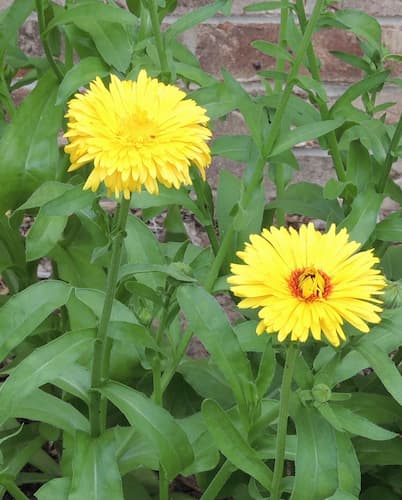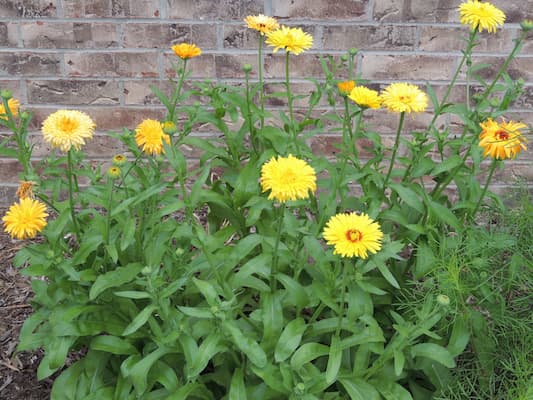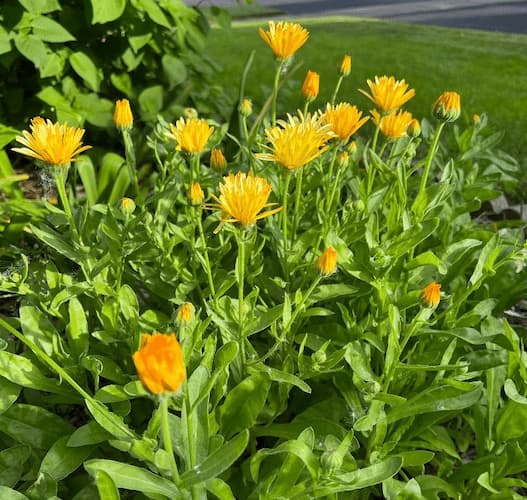How to Grow Calendula Flowers, Pot Marigold

Growing Calendula Annual Flowers in Your Home Garden
Growing Calendulas in your flower garden is easy. They are a very prolific, easy-to-grow annual flower. Also known as “Pot Marigolds”, they are members of the marigold family. Daisy-like Calendula flowers grow atop long stems. Calendulas make great indoor arrangements, but need to be checked for aphids before bringing them in. They make good dried flowers, too. They would be more popular, but they give off an unpleasant odor that is sometimes too strong indoors. This guide on “How to Grow Calendulas” will show you just how easy they are to grow. Then, acquire some calendula seeds and get growing a beautiful crop of Calendulas.
While technically, they are a perennial, they are short-lived. So, most gardeners think of them and grow them as an annual.
Pot Marigolds look best planted in groups. Grow them in a flower garden or in wildflower settings. They look great at the base of small-growing trees. Also, try the on flowerpots and containers on your patio or deck.
Calendulas also make great companion plants in your vegetable garden. Their flowers attract pollinators.
Did You Know? The flowers are used to make a rich yellow dye. Ancient Roman and Greek cultures are among those that used them to dye clothes and a variety of items.
Calendula Flower Plant Specifications
Flower Colors: Calendulas produce orange, yellow, red, and lemon-colored blooms.
Flowers Bloom: Flowers will bloom from mid-summer until frost.
Plant Height: 12″ to 24″.
Light Requirements: Full sun to partial sun.
Ideal Soil pH: 6.0 – 7.0.
Hardiness Zone: 2 – 11. This versatile plant grows well in most hardiness zones.
Toxicity: The leaves and flowers of Calendulas are edible.
Native To: Mediterranean region.
Plant Type: Annual
Botanical Name: Calendula Officinalis
Are Calendula Plants Edible?
YES!!
Calendula has a peppery and slightly bitter taste. The petals are used in soups, stews, and salads. Calendula leaves can also be used for decorating cakes.
Use the flowers and leaves fresh or dried.
Calendula Plant Medicinal Uses
The Calendula plant has a side variety of medicinal applications. Some of the uses are:
- Use it to relieve sore throat.
- It reduces pain, inflammation, and fever.
- Use it as a treatment for skin conditions including burns, infections, rashes, and wounds.
In addition to their medicinal uses, they are used in cosmetics, too.
Annual Calendula Flower Plant Propagation
Calendula are grown from seeds. Sow Calendula seeds early in the season, and cover lightly with 1/4″ of garden soil. They germinate easily and will grow quickly, producing their first of a continual display of blooms by mid-summer.
Select a location in your garden where they can grow undisturbed for years and years. The flowers are terrific re-seeders. They will drop their seeds and reseed your flowerbed year after year.
Space plants 15″ apart.
Days to Germination: 10 – 14 days.

Light Requirements
Pot Marigolds grow best in full sun or partial sun. However, in partial sun, the stems grow lanky and are susceptible to falling over in the wind.
The plants can die off in hot areas of the country. In these regions, the plants grow better when shaded from hot afternoon sunlight.
How to Grow Calendulas
These flowers can grow in most hardiness zones, they grow best in areas of low humidity and cooler temperatures. Low maintenance Calendula plants like rich, well-drained soil, but are very tolerant of average to slightly poor soils. Improving your soil quality will produce much healthier plants and flowers, so add plenty of compost.
Add a general-purpose fertilizer once every six to eight weeks. Do not over fertilize the plants. Too much fertilizer can result in spindly plant stems.
Once your Calendula plants are established, they should grow well, even if left unattended. Water them during dry periods, once or twice per week.
While the plants are still small, pinch back the growing tips on the stems. This results in a bushier, more attractive plant.
Add mulch around the plants for appearance and to keep weeds down.
Early in the summer, your plants will begin to produce large flowers on long stems. They will continually produce flowers even after the first light frost. As you pick the flowers for indoor arrangements, look carefully at the stem and the undersides of the leaves for aphids.
Pick dead blooms to keep the plants neat looking and to encourage new blooms. See: deadheading blooms
Calendula is a somewhat hardy annual. It will not be harmed by a light frost either in the spring or fall. However, the plants will succumb to heavy frosts or freezes.
The seeds are easy to collect after the bloom has died off.
Pruning Calendula Plants
Pruning is not required. However, remove any dead or sickly leaves and stems.
Deadheading plants helps to promote a profusion of new blooms. More on Deadheading Plants.
Insects and Plant Disease
The biggest drawback to Calendulas is that insects like them and they are subject to plant disease. Aphids and whiteflies are the most common insect problem. They are readily treated with insecticidal soap or repellent. Sevin will also work well. Inspect flowers closely before bringing them indoors. Slugs and snails can also be a problem when the plants ae still young, Slug and snail pellets are effective.
The most common disease are mildews, which occur in hot, humid weather or rainy weather. Use fungicides if mildew problems arise. And, avoid water on the leaves and stems as nightfall approaches. Also, wet soil can cause plant root rot.
Also see: Plant Problems – causes and cures.

Related Articles
People who read this article also like:
How to Grow Calendula Plants – by Garden Hobbies
Please support our site. Shop for:
- rmmatthews100@hotmail.com
- 585-721-6528
- Rochester, NY
©1999-2024 GardenersNet.Com, All Rights Reserved

